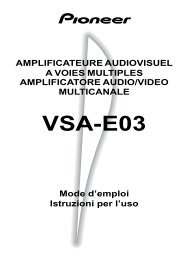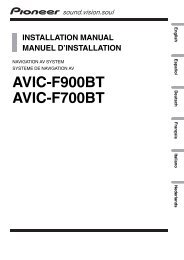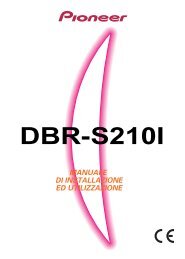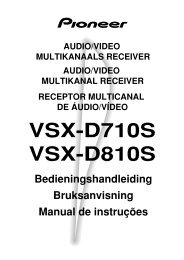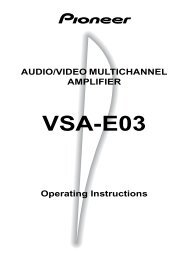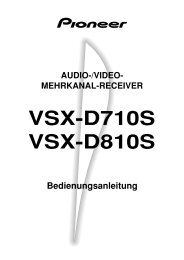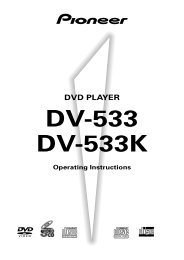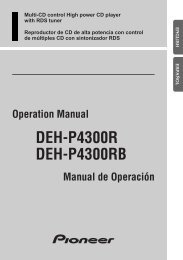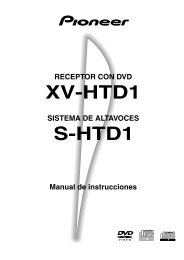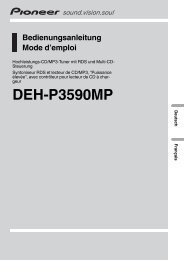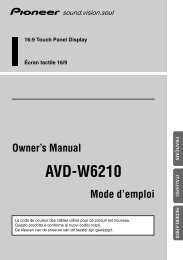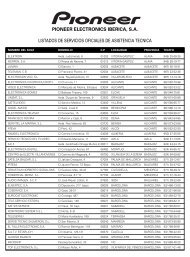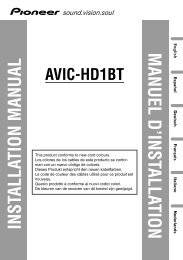XC-F10 M-F10 S-F10-LRW - Service.pioneer-eur.com - Pioneer
XC-F10 M-F10 S-F10-LRW - Service.pioneer-eur.com - Pioneer
XC-F10 M-F10 S-F10-LRW - Service.pioneer-eur.com - Pioneer
Create successful ePaper yourself
Turn your PDF publications into a flip-book with our unique Google optimized e-Paper software.
IMPORTANT<br />
CAUTION<br />
RISK OF ELECTRIC SHOCK<br />
DO NOT OPEN<br />
The lightning flash with arrowhead symbol, within<br />
an equilateral triangle, is intended to alert the<br />
user to the presence of uninsulated "dangerous<br />
voltage" within the product's enclosure that may<br />
be of sufficient magnitude to constitute a risk of<br />
electric shock to persons.<br />
CAUTION:<br />
TO PREVENT THE RISK OF ELECTRIC SHOCK, DO<br />
NOT REMOVE COVER (OR BACK). NO USER-SER-<br />
VICEABLE PARTS INSIDE. REFER SERVICING TO<br />
QUALIFIED SERVICE PERSONNEL.<br />
The exclamation point within an equilateral<br />
triangle is intended to alert the user to the presence<br />
of important operating and maintenance<br />
(servicing) instructions in the literature<br />
ac<strong>com</strong>panying the appliance.<br />
IMPORTANT SAFETY INSTRUCTIONS<br />
READ INSTRUCTIONS — All the safety and operating<br />
instructions should be read before the product is<br />
operated.<br />
RETAIN INSTRUCTIONS — The safety and operating<br />
instructions should be retained for future reference.<br />
HEED WARNINGS — All warnings on the product and<br />
in the operating instructions should be adhered to.<br />
FOLLOW INSTRUCTIONS — All operating and use<br />
instructions should be followed.<br />
CLEANING — Unplug this product from the wall outlet<br />
before cleaning. The product should be cleaned only<br />
with a polishing cloth or a soft dry cloth. Never clean<br />
with furniture wax, benzine, insecticides or other<br />
volatile liquids since they may corrode the cabinet.<br />
ATTACHMENTS — Do not use attachments not<br />
re<strong>com</strong>mended by the product manufacturer as they<br />
may cause hazards.<br />
WATER AND MOISTURE — Do not use this product<br />
near water — for example, near a bathtub, wash<br />
bowl, kitchen sink, or laundry tub; in a wet basement;<br />
or near a swimming pool; and the like.<br />
ACCESSORIES — Do not place this product on an<br />
unstable cart, stand, tripod, bracket, or table. The<br />
product may fall, causing serious injury to a child or<br />
adult, and serious damage to the product. Use only<br />
with a cart, stand, tripod, bracket, or table<br />
re<strong>com</strong>mended by the manufacturer, or sold with<br />
the product. Any mounting of the product should<br />
follow the manufacturer’s instructions, and should<br />
use a mounting accessory re<strong>com</strong>mended by the<br />
manufacturer.<br />
CART — A product and cart <strong>com</strong>bination should be<br />
moved with care. Quick stops, excessive force, and<br />
uneven surfaces may cause the product and cart<br />
<strong>com</strong>bination to overturn.<br />
VENTILATION — Slots and openings in the cabinet are<br />
provided for ventilation and to ensure reliable<br />
operation of the product and to protect it from<br />
overheating, and these openings must not be<br />
blocked or covered. The openings should never be<br />
blocked by placing the product on a bed, sofa, rug,<br />
or other similar surface. This product should not be<br />
placed in a built-in installation such as a bookcase or<br />
rack unless proper ventilation is provided or the<br />
manufacturer’s instructions have been adhered to.<br />
POWER SOURCES — This product should be operated<br />
only from the type of power source indicated on the<br />
marking label. If you are not sure of the type of<br />
power supply to your home, consult your product<br />
dealer or local power <strong>com</strong>pany.<br />
LOCATION – The appliance should be installed in a<br />
stable location.<br />
NONUSE PERIODS – The power cord of the appliance<br />
should be unplugged from the outlet when left unused<br />
for a long period of time.<br />
GROUNDING OR POLARIZATION<br />
If this product is equipped with a polarized alternating<br />
current line plug (a plug having one blade wider than<br />
the other), it will fit into the outlet only one way. This<br />
is a safety feature. If you are unable to insert the plug<br />
fully into the outlet, try reversing the plug. If the plug<br />
should still fail to fit, contact your electrician to<br />
replace your obsolete outlet. Do not defeat the<br />
safety purpose of the polarized plug.<br />
If this product is equipped with a three-wire<br />
grounding type plug, a plug having a third (grounding)<br />
pin, it will only fit into a grounding type power outlet.<br />
This is a safety feature. If you are unable to insert the<br />
plug into the outlet, contact your electrician to<br />
replace your obsolete outlet. Do not defeat the<br />
safety purpose of the grounding type plug.<br />
POWER-CORD PROTECTION — Power-supply cords<br />
should be routed so that they are not likely to be<br />
walked on or pinched by items placed upon or<br />
against them, paying particular attention to cords at<br />
plugs, convenience receptacles, and the point where<br />
they exit from the product.<br />
OUTDOOR ANTENNA GROUNDING — If an outside<br />
antenna or cable system is connected to the product,<br />
be sure the antenna or cable system is grounded so<br />
as to provide some protection against voltage surges<br />
and built-up static charges. Article 810 of the National<br />
Electrical Code, ANSI/NFPA 70, provides information<br />
with regard to proper grounding of the mast and<br />
supporting structure, grounding of the lead-in wire<br />
to an antenna discharge unit, size of grounding<br />
conductors, location of antenna-discharge unit,<br />
connection to grounding electrodes, and<br />
requirements for the grounding electrode.<br />
See Figure A.<br />
LIGHTNING — For added protection for this product<br />
during a lightning storm, or when it is left unattended<br />
and unused for long periods of time, unplug it from<br />
the wall outlet and disconnect the antenna or cable<br />
system. This will prevent damage to the product<br />
due to lightning and power-line surges.<br />
POWER LINES — An outside antenna system should<br />
not be located in the vicinity of overhead power lines<br />
or other electric light or power circuits, or where it<br />
can fall into such power lines or circuits. When<br />
installing an outside antenna system, extreme care<br />
should be taken to keep from touching such power<br />
lines or circuits as contact with them might be fatal.<br />
OVERLOADING — Do not overload wall outlets,<br />
extension cords, or integral convenience receptacles<br />
as this can result in a risk of fire or electric shock.<br />
ELECTRIC<br />
SERVICE<br />
EQUIPMENT<br />
GROUND<br />
CLAMP<br />
OBJECT AND LIQUID ENTRY — Never push objects of<br />
any kind into this product through openings as they<br />
may touch dangerous voltage points or short-out<br />
parts that could result in a fire or electric shock.<br />
Never spill liquid of any kind on the product.<br />
SERVICING — Do not attempt to service this product<br />
yourself as opening or removing covers may expose<br />
you to dangerous voltage or other hazards. Refer all<br />
servicing to qualified service personnel.<br />
DAMAGE REQUIRING SERVICE — Unplug this product<br />
from the wall outlet and refer servicing to qualified<br />
service personnel under the following conditions:<br />
When the power-supply cord or plug is damaged.<br />
If liquid has been spilled, or objects have fallen into<br />
the product.<br />
If the product has been exposed to rain or water.<br />
If the product does not operate normally by following<br />
the operating instructions. Adjust only those controls<br />
that are covered by the operating instructions as an<br />
improper adjustment of other controls may result in<br />
damage and will often require extensive work by a<br />
qualified technician to restore the product to its<br />
normal operation.<br />
If the product has been dropped or damaged in any<br />
way.<br />
When the product exhibits a distinct change in<br />
performance — this indicates a need for service.<br />
REPLACEMENT PARTS — When replacement parts<br />
are required, be sure the service technician has used<br />
replacement parts specified by the manufacturer or<br />
have the same characteristics as the original part.<br />
Unauthorized substitutions may result in fire, electric<br />
shock, or other hazards.<br />
SAFETY CHECK — Upon <strong>com</strong>pletion of any service or<br />
repairs to this product, ask the service technician to<br />
perform safety checks to determine that the product<br />
is in proper operating condition.<br />
WALL OR CEILING MOUNTING — The product should<br />
not be mounted to a wall or ceiling.<br />
HEAT — The product should be situated away from heat<br />
sources such as radiators, heat registers, stoves, or<br />
other products (including amplifiers) that produce<br />
heat.<br />
ANTENNA<br />
LEAD IN<br />
WIRE<br />
ANTENNA<br />
DISCHARGE UNIT<br />
(NEC SECTION 810-20)<br />
GROUNDING CONDUCTORS<br />
(NEC SECTION 810-21)<br />
GROUND CLAMPS<br />
Fig. A<br />
POWER SERVICE GROUNDING<br />
ELECTRODE SYSTEM<br />
(NEC ART 250, PART H)<br />
2<br />
En/Fr<br />
NEC — NATIONAL ELECTRICAL CODE



